The Xbox 720 Leak: Fact or Fantasy?
Digital Foundry presents its assessment of the controversial document
Is it genuine? Is it fake? Or so old as to be completely irrelevant? After first getting an early airing at the beginning of May on a little-known website with no media follow-up, the "Xbox 720" document has finally been distributed publicly in all its 56-page glory, offering what is apparently an intriguing glimpse of the future of the entire Xbox brand.
We see connectivity with other devices, we see the evolution of the platform into an all-encompassing media brand, we see sci-fi style augmented reality glasses cropping up in 2014, and finally a transition to full cloud streaming gameplay - and what could be interpreted as the end of consoles as we know it.
"Next-gen tech, transmedia gaming, augmented reality concepts and the end of the console as we know it - the Xbox 720 'leak' strains credibility somewhat but offers some interesting ideas"
At the time we first saw snippets of the original doc, we dismissed it as a hoax. As visionary as certain aspects were, many elements of the basic specs being discussed simply didn't stack up from a technical perspective - and to be brutally thank, they still don't. Beyond the vision, the spec sheet itself makes very little sense whatsoever.
With the actual 56-page Powerpoint file now leaked publicly and the additional notes this give us, it now seems more likely that the presentation is authentic, but also very, very old - dating from summer 2010. The focus is far more on ideas and the value of the overall offering presented in marketing terms rather than providing much in the way of hard data on what is planned for the technical make-up of the new machine. It is perhaps telling that of the 56 pages in the presentation, only one of them details the core technology underpinning the whole exercise, with nebulous specs and metrics that mostly seem to be plucked out of thin air. The documents discuss a $2,000 PC in a $300 box for the living room, but this is somewhat at odds with the actual hardware being proposed.
The system being discussed by Microsoft is essentially two consoles in one. The design is based on the principle of being always on, so a lower power CPU/GPU combination handles background tasks and is also responsible for hardware-driven overlays that allow for other media (TV, video etc) to be working alongside gaming in a picture-in-picture configuration, with support for DVR style functionality. A very vague set of specs is suggested for this background processing - a dual core ARM or x86 processor working in concert with a GPU with 48 ALUs (arithmetic logic units) running at 500MHz.
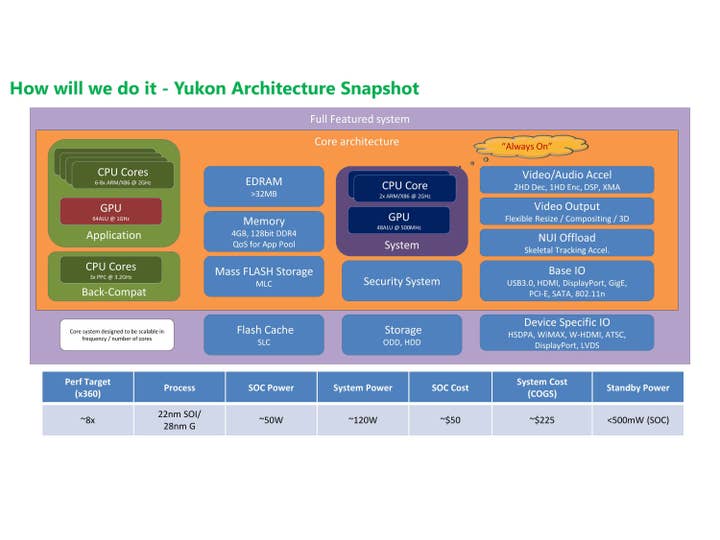

The latter sounds somewhat similar to the Xenos GPU currently found in the Xbox 360, which could be useful bearing in mind that the spec also plans to incorporate the existing Xenon CPU in its entirety for the purposes of backwards compatibility with current games. The notion of including what amounts to an entire 360 CPU seems extreme - Sony did it with the launch PS3s of course, but quickly scaled that back owing to the expense. While Xenon would be very, very small at the latest 28nm production process, servicing backwards compatibility would still make more sense by opting for a new PowerPC core designed to support old games and new - the route Nintendo appears to have chosen with Wii U.
"The idea of an 11/13 core processor with both current and 'next-gen' GPUs contained in a single package that costs just $50 to make comes across as total fantasy"
In terms of main processing, hex or even octo-core ARMs or x86 processors are suggested, along with over 32MB of eDRAM, plus a 64 ALU GPU running at 1GHz. The lack of anything approaching concrete specs is a little puzzling - even at the summer 2010 stage, we would have expected Microsoft to have locked down the absolute basics like the choice of processing architecture. According to highly respected engineers we have talked to, it typically takes at least two years of engineering work to devise a new CPU or GPU, and typically you'd want to give "close to final" kit to developers at least 9-12 months ahead of release. The idea of Microsoft being at the conceptual stage in summer 2010 with no firm decisions on the most basic elements of the architecture seems odd to say the least.
Credibility starts to be strained still further when we look at actual metrics mooted in the docs. Microsoft is targeting an 8x processing power gain over the Xbox 360 and intends to achieve this by integrating all of these components (yes - 11 to 13 cores plus the eDRAM) into a single processor, that only costs $50 to produce and consumes 50W of power, with an overall power envelope of just 125W across the entire system - which makes you wonder what components exactly could account for that additional 75W.
Perhaps we are looking at this with the hindsight of what can actually be achieved at the 28nm process level - something Microsoft's engineers would not have been able to back in summer 2010 - but this all sounds supremely optimistic. Power consumption for the parts listed would be surely be significantly in excess of the 50W level and in a world where it's estimated that the PS Vita SoC costs $16 to produce, the price seems overly optimistic too - 3x the cost for what amounts to a full Xbox 360, plus up to ten CPU additional cores? Significantly, there's more over-optimism in the GPU department too: 64 ALUs at 1GHz would offer nowhere near 8x Xbox 360 performance, even accounting for the evolution in GPU tech since the 360 launched. If 1080p is being targeted, we'd essentially be looking at current gen titles being rendered at full HD with not much else left over.

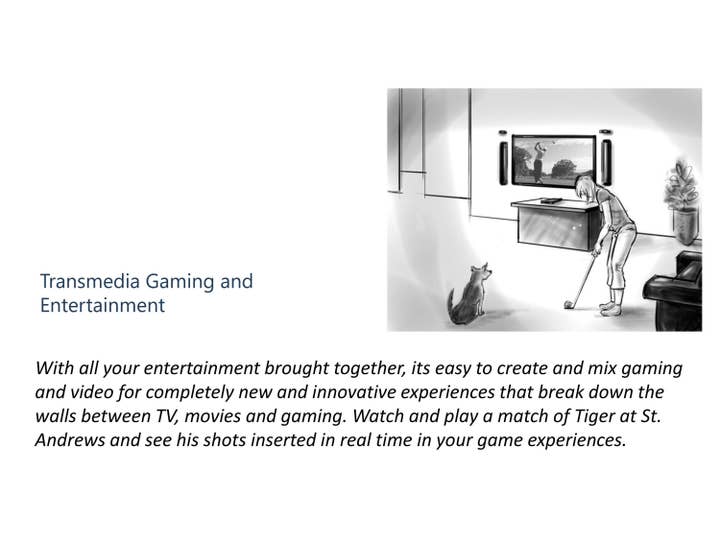
At this point, the leaked document is looking demonstrably dodgy, and the brevity of coverage on the actual hardware (almost zero emphasis, in fact) strongly suggests a basic estimate thrown in there without much thought. That said, now we see the specs page in context of the complete 56-page document, it becomes clear that the actual engineering nuts and bolts in putting together the next-gen Xbox are far from the authors' primary concern. This is a discussion document - and a first draft at that - about where to take the brand next, and how to better integrate gaming with multimedia consumption. If "Yukon" was ever actually a work-in-progress Xbox platform it would be eventually be superseded by other iterations including Project Ten and the current codename, Durango, both of which we have had confirmed from very reliable sources.
"The document furthers the idea of Xbox as a platform for services beyond gaming and suggests the idea of media and content apps that operate concurrently with gameplay"
Clearly the focus of this document is elsewhere. What lends some kind of authenticity to the document is the focus on transitioning the Xbox away from core games only and furthering the notion of the hardware as a portal for services, more tightly integrated with the gaming experience. The idea here is to allow for the layering of content - play Gears of War, and run a specific ESPN ticker app, for example. Picture-in-picture would also be possible, in concert with background TV show recording and media streaming along with a new concept being described as "Transmedia Gaming".
"Watch and play a match of Tiger at St. Andrews and see his shots inserted in real time in your game experiences," says the presentation - suggesting that actual sporting events could beam data into your video games. It's an interesting concept, but once again comes across more as a flight of fancy rather than an actual viable experience. Assuming a live broadcast, someone, somewhere would need to be digitising this data in real-time and beaming it over to the Xbox. In theory, Tiger's in-game performance could be extrapolated from raw stats alone, and another option would be to include the player in live sporting events by giving him his own "turn" on the course while the real event occurs concurrently.
Another intriguing concept is the idea of virtual hangouts where players interact with other gamers in basic social games, while the environment plays host to multiple sporting videostreams, which feeds real-time data to a fantasy football simulation. On a more practical gameplay level there is the suggestion that the new Xbox could also allow for game strategy guides to be run concurrently with the game itself - something we'd imagine people currently do either with guidebooks or via their smartphones or tablets.
Adding credibility to the document are conceptual forerunners to Smart Glass - the new technology that sees media playback rolling from Xbox to tablet to phone, along with "companion content" presumably along the lines of what we saw at E3 - though gameplay applications are not covered. Interestingly this is mooted as a "720 experience" while the reality is that this was bumped up to be a feature of Xbox 360.
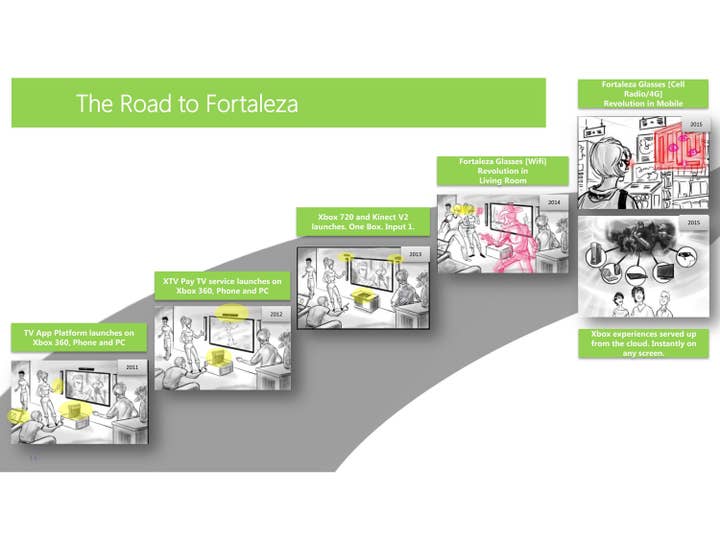
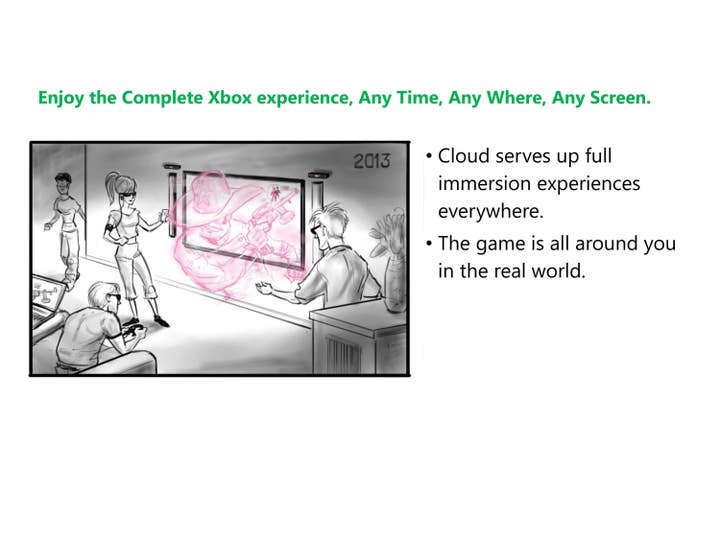
The document also offers a practical solution to some of the issues surrounding the deficiencies of the Kinect motion sensor. Field of view issues are resolved by using two depth cameras working in sync - something that hackers experimenting with the original sensor have already achieved to a certain extent.
"There are some genuinely viable ideas in here in how Kinect could accommodate more varied game-spaces and how 'props' could address the lack of physical feedback in motion gaming."
In addition to the expected increase in precision, four player gameplay is mooted and Microsoft appears to be endorsing the use of "props" - items held in the hand and scanned by the device. The idea here is to address the lack of haptic feedback that holds back the Kinect platform. It's worth pointing out here that the last time I spoke to a Kinect developer, props were not allowed according to the technical requirement checklist - it was thought that using them would compromise the "you are the controller" marketing. However, custom peripherals tracked by Kinect, but with their own connection to the console, is an intriguing combination that could make the system more palatable to the core audience.
Looking forward, "The Road to Fortaleza" suggests that the future of gaming is based around augmented reality glasses that superimpose video game imagery into your current environments, first with a local version apparently using WiFi (probably not the best idea bearing in mind that ultra-low latency would be a requirement for gaming) and with a 4G roll-out later. Whether we're talking about WiFi or 4G, there are considerable issues with latency to address here in terms of accurately mapping rendered 3D over physical reality, not to mention tracking movement. It's interesting to see how much lag reduction was a factor in the creation of John Carmack's recent excursion into virtual reality.
The overall concept is ambitious stuff- similar in principle to how we interpreted Valve's wearable computing concept, but with processing carried out on the main console rather than directly connected to the specs. This presents further challenges though - multiple players, each with their own pair of glasses would require discrete viewpoints to be generated per player, in stereoscopic 3D no less.
The final bombshell in the document is the adoption of cloud streaming, working in concert with the glasses for Xbox anywhere. In parroting OnLive's "never need to upgrade hardware again line" there is the floating suggestion that the next-gen Xbox would be the last physical console Microsoft would produce. Beyond that there is very little detail: in common with most of the document, this is all about the vision with no real suggestion on how it is going to be achieved.
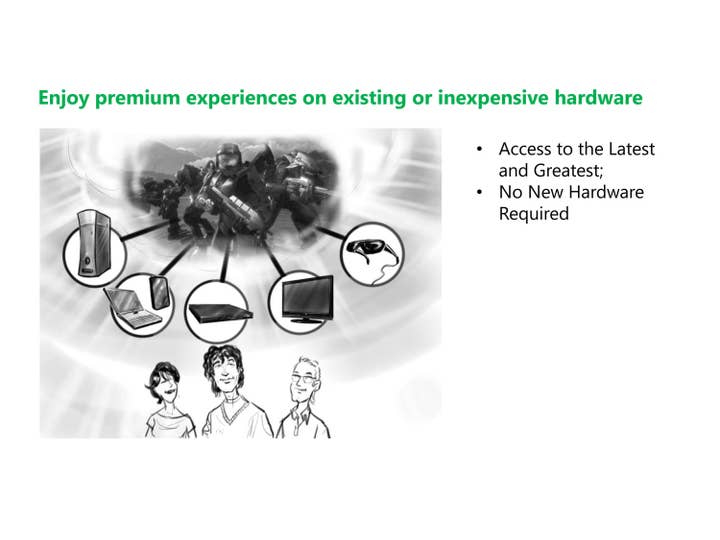

Once the original document began to circulate, it appears to have been the subject of a takedown from a legal firm with Microsoft connections. Does this suggest that the document is genuine? Perhaps. Equally, it may simply be the case that Microsoft would want to limit damage and PR fallout by removing a fake document. The Verge's senior editor, Tom Warren, gave his reasons for believing the document to be genuine.
"The tone of the document suggests some kind of marketing pitch rather than representing any kind of roadmap for the future of Xbox. Microsoft's next-gen secrets almost certainly remain intact"
Assuming it is real, the overall tone of the pitch here looks very much like an exercise in getting the basics together for some kind of raw marketing proposition for the console - the basis for a discussion amongst a very small team, with only token input from the engineering department. The single page of "answers" we get on technological issues - the nebulous spec - comes across very much like a wishlist of parts based on poorly thought out "back of the envelope" calculations.
What is also intriguing is that whoever put this document together seems to know very little about what was happening in Microsoft elsewhere at the point it was written. Assuming a September 2010 date, Windows 8 was well into development, and just four months away from its ARM reveal at CES 2011. Convergence between devices - including Xbox - was already being planned at that point, yet Windows 8 only warrants a single mention in the entire 56-page document. Similarly, plans to expand integration of other Microsoft properties such as Bing and Internet Explorer also escape mention completely, suggesting a very narrow focus.
So is it really authentic? If it is, the notion that it is a "discussion" document should be stressed - the various flights of fancy we see here are mostly backed with little info on how they will be achieved, ignoring all practical challenges that would need to be overcome to make these things happen. While Microsoft appears to have scrambled its legal team to take down the initial point where the document leaked, the company can rest easy: the secrets of the next-generation Xbox almost certainly remain intact.
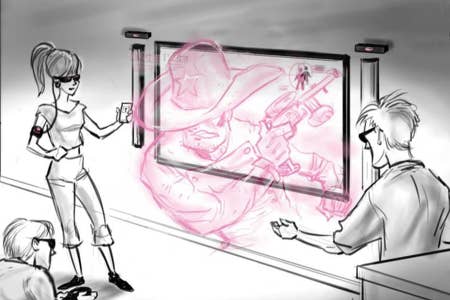


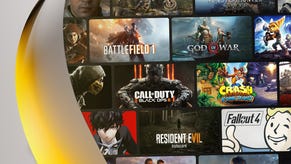

.jpg?width=291&height=164&fit=crop&quality=80&format=jpg&auto=webp)



